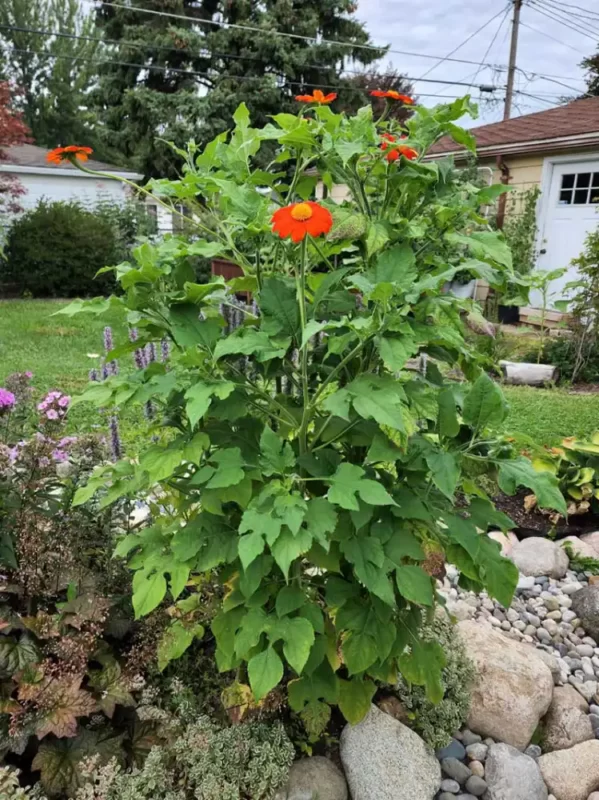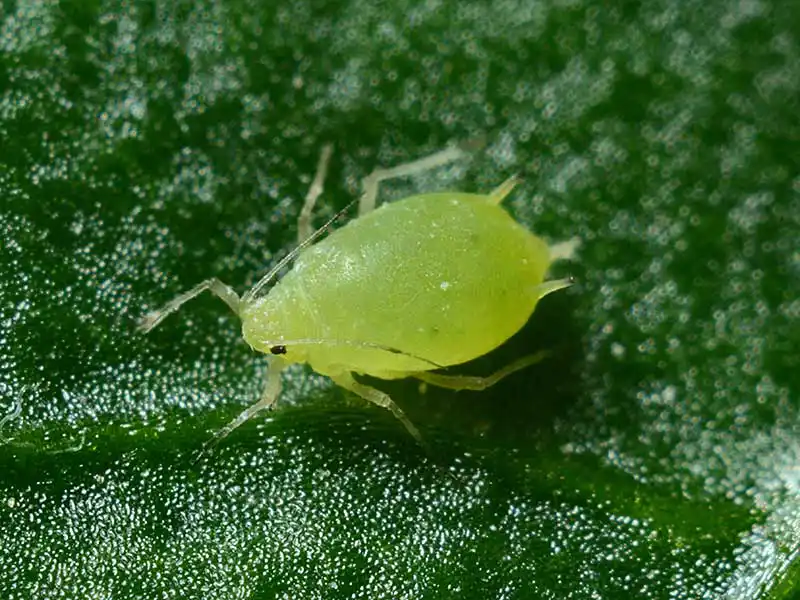Flower Gardening
How To Grow Mexican Sunflowers from Seed: Sowing Sunshine
It’s easy to grow Mexican sunflowers from seed. They require little maintenance, making them an excellent choice for beginner gardeners. In this article, we will discuss everything you need to know about growing Mexican sunflower plants from seed to maturity.
About Mexican Sunflower Plants
Mexican sunflowers (Tithonia rotundifolia) are beautiful, vibrant flowers that are native to Mexico and Central America. They are a popular choice for gardeners who want to add a pop of color to their landscape.
The large plants produce bright orange or yellow flowers that are up to 3 inches in diameter. The flowers are daisy-like with numerous petals surrounding a prominent central disk. The flowers bloom in late summer and fall and are highly attractive to bees, butterflies, and other pollinators.
The plant features hairy leaves of considerable size, measuring up to 10 inches in length and 6 inches in width. These leaves are deeply lobed and have toothed margins. The dark green foliage grows in a rather unkempt manner, with flowers emerging on long stems.
The plants grow large fast and can reach up to 8 feet tall, making them a great choice for creating a natural privacy screen.
Mexican sunflowers thrive in hot and dry conditions due to their extensive taproot. These plants flourish in full sun and well-draining soil, making them an ideal choice for pollinator gardens. In regions with warmer climates, they can be cultivated as perennials, but in colder areas, they are classified as annuals.
Types of Mexican Sunflowers
There are several different types of Mexican sunflowers, each with its unique characteristics. Some of the most popular varieties include:
- Tithonia rotundifolia: This is the most common type of Mexican sunflower, known for its bright orange or yellow flowers that bloom from mid-summer to fall.
- Tithonia diversifolia: This variety has larger leaves and flowers than Tithonia rotundifolia and is also known as the tree marigold.
- Tithonia speciosa: This type of Mexican sunflower has deep red flowers and is also known as the Red Torch Mexican Sunflower.
Are Mexican Sunflowers Invasive?
Mexican sunflowers are not considered invasive in most areas, but they can self-seed and spread quickly if not managed properly. To prevent them from spreading, remove any dead flowers before they have a chance to drop their seeds, and keep an eye out for any new seedlings that may appear.
When to Plant Mexican Sunflowers
The best time to plant Mexican sunflowers is in the spring, after the danger of frost has passed. They can also be planted in the summer or fall, but they may not grow as well during these times.
Choosing the Right Location
Mexican sunflowers thrive in full sun, so it’s essential to choose a location that receives at least 6-8 hours of direct sunlight each day. They also prefer well-draining soil with a pH level of 6.0-7.5. If your soil is heavy and clay-like, add some organic matter, such as compost or peat moss, to improve drainage.
Starting From Seed: Grow Mexican Sunflowers

You can start Mexican sunflowers from seed both indoors and outdoors, and each method has its advantages. Starting seeds indoors allows you to get a head start on the growing season and gives you greater control over the environment, such as temperature and moisture. This method is particularly useful if you live in a region with a short growing season.
On the other hand, sowing Mexican sunflower seeds directly into the ground outdoors is easier and requires less equipment. This method also eliminates the need for transplanting, which can be stressful for young plants. Ultimately, the decision on whether to start your Mexican sunflowers indoors or outdoors will depend on your individual circumstances and gardening preferences.
Grow Mexican sunflowers from seed indoors:
- Fill your seed starting tray with seed starting mix.
- Plant the Mexican sunflower seeds at no more than a 1/4″ depth, they need light to germinate
- Water the seeds thoroughly but gently.
- Place the seed starting tray in a warm location.
- Use a humidity dome to keep the soil moist until the seedlings emerge.
The seeds will germinate in 1 to 3 weeks. Be sure to give the seedling at least 8 hours of direct sunlight or use a grow light for seed starting. A few weeks after germination, your Mexican sunflower seedlings should be large enough to transplant into larger 4″ nursery pots or directly into your garden if the last frost has passed. Be sure to harden off seedlings grown using artificial light before exposing them to the full sun.
Here’s how to grow Mexican sunflowers from seed outdoors:
- Choose a location with full sun and well-draining soil.
- Prepare the soil by removing any weeds or debris and breaking up any clumps.
- Plant the Mexican sunflower seeds at no more than a 1/4″ depth, they need light to germinate
- Water the seeds thoroughly but gently.
- Keep the soil moist but not waterlogged until the seedlings emerge.
Within one to three weeks, your Mexican sunflowers should begin to sprout.
Caring for Mexican Sunflowers

Mexican sunflowers are relatively low maintenance, but they do require some care to thrive. Here are some tips to help your Mexican sunflowers reach maturity:
Watering
Mexican sunflowers require about 1 inch of water per week, either from rainfall or watering. Water the plants deeply but infrequently, as this encourages the roots to grow deep into the soil.
Fertilizing
Mexican sunflowers don’t require a lot of fertilizer, but a little can help them grow more robust and produce more flowers. Use a balanced water soluble fertilizer, such as a 10-10-10 or 20-20-20, and apply it according to the manufacturer’s instructions.
Pruning
Mexican sunflowers don’t require much pruning, but it can help them grow fuller and produce more flowers. Pinch back the tips of the plants when they are about 12 inches tall to encourage them to branch out. You can also deadhead the flowers as they fade to encourage more blooms.
Common Pests and Plant Diseases

Like all plants, Mexican sunflowers can be susceptible to certain pests and diseases. Here are some common issues to watch out for:
| Problem | Symptoms | Treatment |
|---|---|---|
| Aphids | Sap-sucking insects that cause distorted growth and yellowing of leaves. | Spray plants with water or use insecticidal soap. |
| Spider mites | Tiny pests that cause webbing, yellowing of leaves, and loss of vigor. | Spray plants with water or use insecticidal soap. |
| Powdery mildew | Fungal disease that causes white, powdery coating on leaves and stems. | Remove affected leaves and treat with fungicide. |
| Leaf spot | Fungal disease that causes circular brown or black spots on leaves. | Remove affected leaves and treat with fungicide. |
| Root rot | Fungal disease that causes wilting, yellowing, and eventual death of the plant. | Remove affected plants and treat the soil with fungicide. |
| Whiteflies | Sap-sucking insects that cause yellowing and wilting of leaves. | Spray plants with water or use insecticidal soap. |
Mexican Sunflowers as Cut Flowers
Mexican sunflowers typically bloom from mid-summer to fall, and the flowers can be collected once they have fully bloomed. The stems are hollow and fairly delicate so be sure and use a sharp knife or pruners to harvest the long stems. Cut the flowers just above a pair of leaves, and they can be used in floral arrangements or left to dry for later use.
Maria’s Experience Growing Mexican Sunflowers
One of my friends, Maria, is an avid gardener who loves to experiment with different types of flowers. Last spring, she decided to plant Mexican sunflowers for the first time. She followed the steps to start the seeds outdoors and was amazed at how quickly they grew.
By mid-summer, Maria’s garden was bursting with bright orange flowers that towered over most of her other plants. The Mexican sunflowers created a natural privacy screen that attracted bees and butterflies to her garden. She loved watching the insects buzz around the flowers, and she was delighted by how easy they were to care for.
By the end of the summer, Maria’s Mexican sunflowers had grown to be over 6 feet tall and were covered in hundreds of vibrant orange flowers. She was thrilled with the result. She enjoyed bringing fresh cut flowers into her home to brighten up her rooms.
Conclusion
It’s easy to grow Mexican sunflowers from seed to maturity since they require very little maintenance. Just be sure and choose a location with full sun and well-draining soil, plant the seeds in the spring, and water them deeply but infrequently. Fertilize them occasionally, pinch back the tips of the plants, and control any pests or diseases that may arise. With these simple steps, you can enjoy a beautiful display of vibrant Mexican sunflowers in your garden.
FAQ: Grow Mexican Sunflowers
Do Mexican sunflowers come back every year?
Mexican sunflowers are annuals, which means they complete their lifecycle in one growing season and do not come back every year. However, they readily reseed themselves, and you may find new plants growing in the same area the following year.
How do you save Mexican sunflower seeds?
To save Mexican sunflower seeds, allow the flower heads to dry on the plant completely. Once the heads have dried, remove them and break them open to reveal the seeds. Separate the seeds from the chaff and store them in a cool, dry place until you are ready to sow them.
Do birds eat Mexican sunflower seeds?
Yes, birds are known to eat Mexican sunflower seeds. If you want to save the seeds for planting, it’s a good idea to harvest them before they fully dried to avoid losing them to hungry birds. Optionally, you can cover the spent blooms with organza bags to keep the birds from nibbling.
Do monarch butterflies like Mexican sunflowers?
Yes, monarch butterflies are attracted to Mexican sunflowers because of their bright colors and abundant nectar. Mexican sunflowers are a great addition to butterfly gardens.
Are Mexican sunflowers true sunflowers?
No, Mexican sunflowers (Tithonia) are not true sunflowers (Helianthus annuus). While both plants belong to the same family, Asteraceae, they are distinct species with different characteristics.





